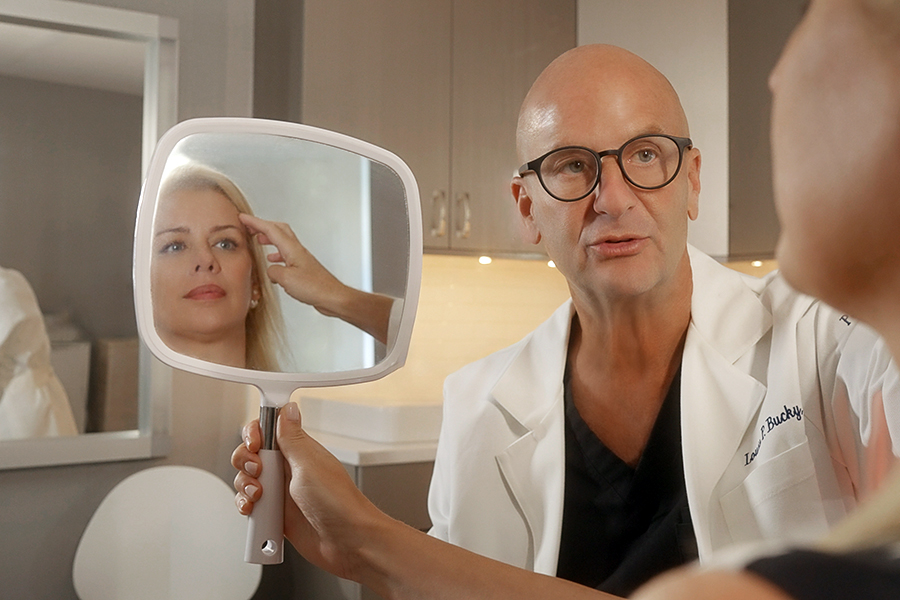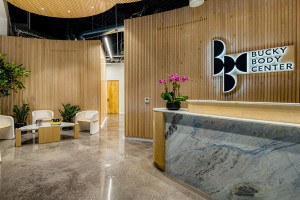Why a Different Approach to Facelifts Is Taking Off Among Philadelphians of All Ages

A facelift, one of the mainstays of plastic surgery, might seem too well-established to become a new trend. But in recent years there’s been a sea-change in the approach to the procedure–and it’s making facelifts a fresh favorite of people of all ages. If you haven’t heard the news, it might be because the new approach to facelifts produces more natural-looking results than the old approach.
“Facelifts needs a rebrand. It’s not the operation that you do in your 70s. Younger people can get a lot out of a lift in order to look natural, refreshed, less tired, less angry at an earlier stage, so when they’re in the prime of their life, they can look as good as they feel,” says Dr. Louis P. Bucky, founder of Bucky Plastic Surgery and the Bucky Body Center in Philadelphia. “If you consider the fact that the operation can be done with a quicker recovery, it’s much more amenable to the active, younger individual who can look excellent for a decade. And when performed at a younger age when the skin quality is better, the end result is a more subtle, refreshed look, rather than a more significant rejuvenation.”
Bucky is one of the top-rated plastic surgeons in the world for facelifts (he’s currently ranked twelfth in the U.S. by Newsweek) and he’s previously performed live surgery on patients, broadcast globally, to instruct other physicians on the contemporary, ideal process. The method that he has endorsed–which brings together innovative techniques such as the use of diluted fat–has gained traction in recent years. And as its popularity has grown, it’s helped to create a new understanding of facelifts among discerning clientele–one that is more about lifting and refining the face than it is about just pulling the skin tight.
As a result, the facelift is being adopted as a method of more naturally maintaining or de-aging the face without erasing its unique characteristics–even among younger generations. And as Bucky’s technique in setting back the clock continues to become more well-known, it could help change our idea of not just facelifts, but what’s possible in maintaining our look despite the everyday stresses of life and aging.

Patients who receive a facelift at Bucky Plastic Surgery recover in a luxury suite at the Ritz Carlton Philadelphia.
Finding the Right Approach
Former patient Patricia Clarke is a prime example. Like many people just over the age of 30, Clarke had felt her slowing metabolism and resultant body weight catching up to her. Through diet and exercise, she got herself back on track by 36–but was left feeling like she looked, suddenly, much older. Clarke would flip through photos of herself, dismayed at how her sagging neckline unnecessarily aged her.
“My skin was super stretchy. Every picture I would see, I just felt old,” Clarke says. “Every picture I was in, I hated it.”
She began to search for plastic surgeons who could alleviate her anxiety about how she looked, but the surgeons she spoke to had a different idea of facelifts than she was hoping for. It’s still fairly common to think of facelifts as something you do late in life to reduce wrinkles, rather than restructure the face to bring it back to where it was before weight-loss, trauma, sagging due to aging, or some combination of these factors.
But that’s when she met Bucky. During consultations with patients, Bucky uses photos of previous cases to help the patient determine what will work best for them, and makes sure both doctor and patient have the same goals. In Clarke’s case, while she was primarily focused on her neck, Bucky suggested adding fat to her lower cheek to improve the overall result. But both were on the same page–they wanted to get Clarke back to where she was before her weight gain and loss.
After one consultation in which Bucky told her what was possible, Clarke left his office to consider her decision about moving forward with the procedure. Before she even left the parking lot, she made up her mind, and she headed back in. She wanted the facelift.





A Transformative Technique
Clarke opted for the procedure because Bucky offered something very different from the other plastic surgeons she spoke to. Bucky’s vision for the facelift involves bringing together multiple different techniques to accomplish a natural-looking shift in the face that avoids trauma to, or erasure of, your natural features, and produces a quick recovery period–as low as two weeks.
He starts by applying the tumescent technique, injecting fluid into the tissues of the face to gently lift and separate them, making them more manipulable. The fluid contains agents such as lidocaine that reduce bruising and pain, limiting trauma and the need for anesthesia.
“The tumescent technique leads to a much easier operation to perform, and more importantly for patients to recover from,” Bucky says. “It also sets up the next stage.”
The loosening of the tissue allows Bucky to reach and manipulate the deep planes of the face. While more primitive facelifts are more or less focused on simply pulling the top layer of the skin tight, aging is driven by drooping facial features caused by gravity over time. Bucky shifts these components of the face vertically–back to where they were at a younger age.
“It truly is an antigravity procedure,” Bucky says.
Bucky then refines this restructuring with fat grafting. The other major factor in aging is a loss or redistribution of fat in the face. Bucky takes fat from other areas of the body, and places them in areas of the face where they’re needed.
Finally, there’s also fat loss in the skin itself, causing a more “crepey” look as skin loses elasticity. This can be particularly noticeable in the neck, something that was driving Clarke’s initial concerns. To combat this, Bucky injects diluted, liquid fat into the tissue layer beneath the skin, which fills out the microscopic folds that are causing the skin to droop.
“It creates a regenerative layer between the skin and the muscle that really makes it soft and youthful,” Bucky explains.
A Quick Rest and Recovery
Instead of pulling the skin, the procedure smoothly moves the components of the face back into place. And this produces better results while reducing recovery time. The shorter recovery is not only less painful, but Bucky designs the recovery consciously as another integral component of the facelift. Each patient has the opportunity to stay their first night of recovery at the Ritz Carlton Philadelphia (instead of a hospital), where they also receive support from their own nurse. Bucky personally comes to the hotel to check on the patient’s recovery status, then clears them to head home. The road to recovery starts early enough that the intention is for patients to stay only one night away. Clarke notes this was one of the most important aspects of her positive experience.
“You have a private nurse, who takes care of anything you need,” Clarke says. “It was absolutely amazing.”
She also loved the fact that Bucky’s team continued their relationship with her post-op. Facelifts are a major procedure, so healing takes care, and whenever an issue arose, Clarke was able to call the Bucky staff and get help.
“If I had any problems, the staff would say, take a picture, send it in. I did. And they immediately said, come on in and take care of it,” Clarke says. “The staff was just amazing throughout the entire process.”
This ethos extends to Bucky’s medical program after the procedure. During the procedure, Bucky is careful about the incision he performs to limit scarring and make a second facelift, if needed years down the road, viable. For the recovery period, he’s built a program to further limit scarring, improve elasticity, and limit and quickly decrease swelling. Manual lymphatic drainage and red light therapy, performed by Bucky, promote circulation and healing, while microneedling, micro-coring and laser resurfacing can help regenerate collagen.
Bucky compares these last steps to painting the house that he’s built. Patients recover faster, and they’re also receiving the final touches that complete the restoration of their younger appearance. Ultimately, the de-aging effect is dramatic, but it has no signs of the stereotypical, “pulled” facelift look–according to Bucky, people often think his patients have lost weight.
A Life-Changing Impact
Because this approach to facelifts creates better results more quickly, they’ve started to take the place of other, nonsurgical treatments that people receive on a recurring basis. As Bucky notes, trends like “liquid facelifts” don’t make sense.
“That’s just a filler, and there’s no filler today that can replace a facelift. There are fillers that help improve volume loss, but they don’t lift,” he says. “Fillers have their place in early aging changes, or can make significant changes in facial balancing or feature enhancement. However, overfilling as a substitute for gravitational changes can be quite distorting.”
To get the best result, patients are increasingly receiving a single successful facelift that can create a youthful effect for a decade.
“If you get it done right and look good for 10 years, it’s a treatment that is very cost effective,” Bucky says.
That has been Clarke’s experience. She received the facelift six years ago, and felt like she was de-aged to her 20s. Now, in her 40s, she still gets mistaken for that age.
“I’m 41 now, and people still think I’m 29,” she says.
She’s proud of the results to the point where she shares her before-and-after photos with people who want to know how she’s managed to stay so young-looking. And more than anything else, she now loves going out–and doesn’t think twice about being photographed.
“Now I love being in pictures, and I’m not always searching for the right angle. I don’t feel like I have this saggy neck–I feel young,” she says. “And I tell everybody I got a facelift. I’m proud of it, because it looks awesome.”
This is a paid partnership between Bucky Body Center and Philadelphia Magazine